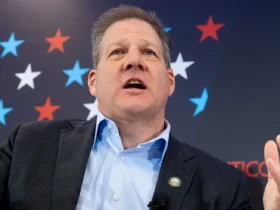In Nebraska, teachers are worried about a new proposal that could change how the state contributes to the retirement plan for public school employees. This proposal, introduced by Governor Jim Pillen and State Senator Beau Ballard, aims to reduce the state’s contribution to the pension plan based on how well-funded it is.
Currently, the state contributes 2% of the total payroll for all school employees in Nebraska each year. This amounts to around $50 million. The plan is now 99.9% funded, with about $16.3 billion in its account. The goal of the proposal is to adjust the state’s contribution depending on the pension plan’s funding level.
If the plan is fully funded (at or above 100%), the state would stop contributing. However, if the funding level falls below 92%, the state would continue contributing the full 2%. The idea is to use the money saved from the state’s contributions to help fund other education-related programs, such as improving school finance and increasing teacher pay.
How the Proposal Works:
Under the proposed law, the state’s contribution would vary according to the funding level of the pension plan. Here’s how it would work:
- If the pension plan is less than 92% funded, the state will contribute 2% of payroll.
- If it is between 92% and less than 94%, the state will contribute 1.6%.
- Between 94% and less than 96%, the contribution will be 1.2%.
- Between 96% and less than 98%, it will be 0.8%.
- Between 98% and less than 100%, it will be 0.4%.
- If the plan is fully funded (100%), the state will stop contributing.
The pension plan is designed to cover all public school employees except those in Omaha Public Schools, which have their own pension plan. The changes could directly affect thousands of teachers in the state.
Teachers Raise Concerns
Many teachers and education groups, including the Nebraska State Education Association (NSEA), are concerned that this proposal could harm the financial health of the pension plan. The NSEA, which represents more than 26,000 educators, says that the state’s current 2% contribution is essential for the security of teachers’ retirements.
Tim Royers, the president of NSEA, explained that the pension plan was in a much worse condition in 2013, when it was only 75% funded. Back then, teachers stepped in to fill a large gap, and the state increased its contribution. Now that the plan is in a much stronger position, teachers worry that reducing the state’s contribution could hurt the system’s stability.
Some teachers, like John Heineman, a retired educator, believe that the pension plan should remain strong and attractive to new teachers. Heineman said that the current system has worked well and should not be changed.
Governor’s Intent
Governor Pillen argues that the proposal is about being fiscally responsible and that the state should not continue contributing money to a plan that is already well-funded. According to the governor’s office, the goal is to free up funds for other educational investments, such as teacher salaries, without affecting the pension money that teachers and school districts have contributed.
Kenny Zoeller, the director of the governor’s Policy Research Office, stressed that the funds saved from the state’s contributions would be used for education-related purposes, not to cover the state’s budget shortfall. He emphasized that the state’s focus is on ensuring the pension system remains healthy.
Mixed Reactions from Lawmakers
State Senator Danielle Conrad, who has served for many years, disagrees with the fast-paced approach to changing the pension plan. She believes lawmakers should have more time to discuss the potential impacts of the changes and listen to teachers’ concerns before making any decisions.
Conrad and others worry that rushing the proposal could create unnecessary stress for teachers, who have already been dealing with changes in their benefits over the past decade. She hopes that lawmakers will reconsider the proposed changes and work with teachers to find a solution that keeps the pension system strong.
Possible Alternatives
Some teachers suggest that the state should look at other ways to improve the pension system, such as reducing the contribution levels for teachers or offering better benefits for new employees who entered the system after 2013. These alternatives could help increase teachers’ take-home pay while ensuring that the pension plan remains healthy.
Looking Ahead
The proposal is still in the early stages, and it will need further review before any changes can be made. An actuarial study will be conducted to assess how the proposed changes would affect the pension system. In the meantime, educators, lawmakers, and the governor’s office are continuing to discuss possible solutions to balance the state’s budget while ensuring that teachers’ retirements remain secure.
The debate over Nebraska’s school retirement plan highlights the ongoing challenge of funding education while protecting teachers’ future security. As lawmakers consider these changes, it is clear that teachers are watching closely and advocating for a solution that supports both their work and their future.
(Source: newsbreak.com)













Leave a Reply